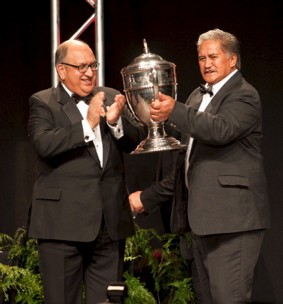Ahuwhenua Trophy Awards

Tihe Mauriora! Ka tautoko ahau, I ngā kupu whaikōrero, I runga i ngā paepae o te pōwhiri. Kia ora huihui tātou katoa. I acknowledge and support the words spoken on the welcoming paepae. Greetings to all those gathered.
I then begin my kōrero Ingarihi by greeting everyone in the languages of the realm of New Zealand, in English, Māori, Cook Island Māori, Niuean, Tokelauan and New Zealand Sign Language. Greetings, Kia Ora, Kia Orana, Fakalofa Lahi Atu, Taloha Ni and as it is the evening (Sign)
I then specifically greet you: Arikinui Sir Tumu te Heuheu, Paramount Chief of Ngāti Tūwharetoa; Ministers of the Crown, Hon David Carter, Minister of Agriculture , and Hon Georgina te Heuheu, Minister of Courts and Associate Minister of Māori Affairs ; Hon John Luxton, former Minister of Agriculture; Kingi Smiler, Chair of the Ahuwhenua Trophy Executive Committee and your fellow committee members; Doug Leeder, Chief Judge and your fellow judges; Ahuwhenua Trophy finalists and previous recipients; Distinguished Guests otherwise; Ladies and Gentlemen.
Thank you for inviting me to the 2010 Ahuwhenua Trophy Awards Dinner here in Taupō, which this year recognises excellence in dairy farming.
As we will hear later this evening, the Ahuwhenua Trophy has a fascinating history. Without pre-empting what others have to say, it is a history that reflects the upheavals of farming in New Zealand and of Māori farming in particular.
My particular interest is that it was my predecessor as Governor-General, Lord Charles Bledisloe, who gifted the Ahuwhenua Trophy to recognise excellence in Māori farming.
Lord Bledisloe had several passions and one of them was agriculture and forestry, on which he gave many speeches. In addition to the Ahuwhenua Trophy, he also donated the Bledisloe Trophy for excellence in horticulture.
As an aside, the famous New Zealand politician and author from the 1920s to the 1940s, John A Lee recounts that Vincent Ward, the son of the then Prime Minister, Sir Joseph Ward, told him how in 1930 Lord Bledisloe was chosen as Governor-General. In Lee’s book, Political Notebooks, the account goes as follows:
‘A list of nominees was cabled. I read the list to Sir Joseph.
“Who should we select, Vincent?” he asked me.
“Well, there’s a Lord amongst them. It’s about time we had a Lord again. The rank is in keeping with the dignity of the Dominion.”
“What is the Lord interested in, Vincent?”
“Agriculture.”
“Send for him. Send for him,” said Sir Joseph. “What did you say his name was?”’
Seriously, however, whatever may have been Sir Joseph Ward’s reasoning, Lord Bledisloe proved to be a popular choice during the difficult times of the Great Depression. In particular, he seemed to have an innate understanding of the importance of symbols to national identity.
He donated the Bledisloe Cup that now defines rugby rivalry between Australia and New Zealand and he and Lady Elaine gifted the Waitangi Treaty House and Grounds which has provided our nation with a focus for reflection on and celebration of the birth of New Zealand as a modern country.
Despite being an outsider, Lord Bledisloe also had a better understanding than many Pākehā of the value of Māori art, language, heritage, culture and connection with the land.
It is not surprising then that Sir Apirana Ngata recognised that Lord Bledisloe, as a man interested in matters Māori and agricultural, would be a willing participant in promoting an award to recognise excellence in Māori farming.
In preparing my remarks for this evening, I had the opportunity to read the original rules drawn up by Sir Apirana and which Lord Bledisloe approved. The criteria were rigorous. In addition to considering fertiliser, seeds and implements, the rules also required the judges to consider: “…good husbandry, economy of management with view to a commercial profit, the cleanliness and neatness of the holding and the progress made by the farmer in the development of the holding…”
While the rules have naturally changed and adapted to modern circumstances, I understand the criteria are no less rigorous. They include issues around health and safety, staff welfare, communication, governance, environmental strategies and Ngā Tikanga Māori in addition to the purely farming concerns.
Māori farming and Māori farmers have continued to go from strength to strength. As just one example, I note that the 2006 winner of this award, Parininihi Ki Waitotara Incorporation, is now the largest milk supplier in Taranaki . As tonight’s finalists amply illustrate, starting from the fundamental concept of kaitiakitanga, Māori farmers have also been at the forefront of advancing sustainable farming that respects the environment as well as the bottom line.
So in conclusion, I congratulate the finalists of the 2010 Ahuwhenua Trophy and I look forward to presenting it to the winner shortly. Winner or not, to have reached this point you have displayed outstanding farming skills of which you can be rightly proud and a commitment to Māoritanga in a wider sense. There is an apposite Māori proverb that makes this point well: “Toi te kupu, toi te mana, toi te whenua ” which of course translates as “The permanence of the language, prestige and land.”
And that is the note on which I will close in Māori, by offering everyone greetings and wishing you all good health and fortitude in your endeavours. No reira, tēnā koutou, tēnā koutou, kia ora, kia kaha, tēnā koutou katoa.
